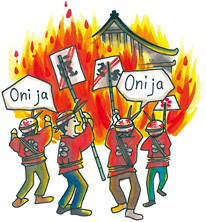Hakata Culture vol.30
A lot happens on January 7

January 7 is known as Nanokashogatsu, and it has long been the date for the custom of eating the “seven wild herbs of spring” to cure any illness. These seven herbs are water dropwort, shepherd's purse, cudweed, chickweed, nipplewort, lapsana, turnip, and daikon. Years ago, these herbs grew wild near people’s homes, and turnip and daikon were cultivated in gardens.
The custom of eating these herbs arose because they were the first to sprout in the new year and were therefore thought to be filled with energy. In addition, people would have had their fill of osechi ryori, the traditional New Year’s fare, by this time. Furthermore, they would have been fatigued by all the special events and partying during the holiday season, and their stomachs would have been weakened. As a remedy for this, these seven herbs were used as the ingredients in okayu, a kind of rice porridge. In Hakata, however, many families used them to make a thinner soup than okayu, which might be better called nanakusajiru.
Today, these herbs are sold in bundles in Japanese supermarkets and convenience stores on January 6 and 7. The custom of eating this dish was first recorded in a document dating from 1362, but it was not until the Edo period (1603-1868) that it spread among samurai families and the general public.
January 7 is also the date of one of Japan’s three major fire festivals at the Dazaifu Tenmangu. That is the impressive Onisube, which begins at 9:00 p.m. As the participants chant “Oni ja, oni ja,” fire and smoke is used to flush out the demons who have secluded themselves in the Onisube-do.
Another event held on January 7 is usokae which takes place at 7 a.m. People visit the shrine grounds, wave a wooden model of the uso bird, and chant, "kaemasho, kaemasho" (change them, change them). This is supposed to clear away all the lies (uso) of the past year. The event is held to welcome the new year with a refreshed state of mind.
Why not get into the spirit of the season, savor some nanakusa gayu in the morning, and pay a visit to the Dazaifu Tenmangu that night?
A public relations manager
Kimiyo Sasaki
1月7日は迎春の行事でいっぱい
1月7日は七日正月といわれ、この日に春の七草を食べると万病を取り除くといわれる古くからの風習があります。春の七草とは、セリ、ナズナ、ゴギョウ、ハコベラ、ホトケノザ、スズナ、スズシロ。この順番が日本人には覚えやすい音になっています。ゴギョウとはハハコグサ、スズナはカブ、スズシロはダイコンのことで、昔なら家の近所に雑草として生えていたような植物です。カブとダイコンは近所の畑で栽培されていたのでもらっていました。この七草は早春の時期にいち早く芽吹くことからエネルギーが満ちた植物と言って良いでしょう。お正月のおせち料理に飽きたころでもあり、正月疲れが出て胃腸も弱り気味の時期に七草をお粥(かゆ)の具材にして食したのです。でも博多では、お粥よりもみそ汁の具にしていた家庭が多かったようです。七草粥というよりは、七草汁ですね。
七草はいわば日本のハーブ。今では1月6日から7日にかけて、スーパーやコンビニエンスストアで七草を花束のように1セットにして売っています。現在の七草を食べる風習は1362年ころに書かれた文書にあるようですが、江戸時代に武家や庶民の間に広がったようです。
ちなみに1月7日は太宰府天満宮で日本三大火祭りの一つ「鬼すべ神事」が午後9時ころから行われます。「鬼じゃ、鬼じゃ」のかけ声のもと、炎と煙で鬼すべ堂にたてこもる鬼をあぶり出すという迫力ある行事です。その前、午後7時ころから行われるのが「うそ替え神事」。天満宮境内で「木うそ」を手にした人たちが「替えましょう、替えましょう」と言いながら木うそを回し、昨年1年間についた嘘を精算しようというもの。精算して新しい気持ちで新年を迎えようという迎春の行事です。7日の朝は七草を味わって、夜は太宰府天満宮へ出かけましょう。
福岡市広報課長 佐々木 喜美代

